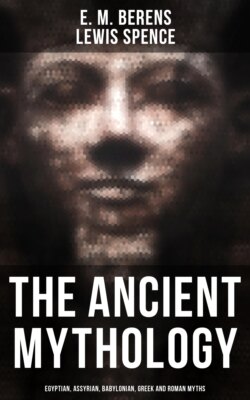Читать книгу The Ancient Mythology: Egyptian, Assyrian, Babylonian, Greek and Roman Myths - Lewis Spence - Страница 48
На сайте Литреса книга снята с продажи.
Bel
ОглавлениеBel, or, to give him his earlier name, En-lil, is spoken of in very early inscriptions, especially in those of Nippur; of which city he was the tutelar deity. He was described as the 'lord of the lower world,' and much effort seems to have been made to reach a definite conception of his position and attributes. His name had also been translated 'lord of mist.' The title 'Bel' had been given to Merodach by Tiglath-pileser I about 1200 B.C., after which he was referred to as 'the older Bel.' The chief seat of his worship was at Nippur, where the name of his temple, E-Kur or 'mountain-house,' came to be applied to a sanctuary all over Babylonia. He was also addressed as the 'lord of the storm' and as the 'great mountain,' and his consort Nin-lil is also alluded to as 'lady of the mountain.' Jastrow rightly concludes that "there are substantial reasons for assuming that his original city was on the top of some mountain, as is so generally the case of storm-deities.... There being no mountains in the Euphrates valley, however, the conclusion is warranted that En-lil was the god of a people whose home was in a mountainous region and who brought their god with them when they came to the Euphrates valley."2
En-lil is undoubtedly of the class of tempest-deities who dwell on mountain peaks. No text appears to have been found which alludes to him as of a red colour. The flashing of the lightning through the clouds which veil the mountain summits usually generates a belief in the mind of primitive man that the god who is concealed by the screen of vapour is red in hue and quick in movement. The second tablet of a text known as the 'crying storm' alludes to En-lil as a storm-god. Addressing him it says: "Spirit that overcomes no evildoing, spirit that has no mother, spirit that has no wife, spirit that has no sister, spirit that has no brother, that knows no abiding place, the evil-slaying spirit that devastates the fold, that wrecks the stall, that sweeps away son and mother like a reed. As a huge deluge it tears away dwellings, consumes the provisions of the home, smites mankind everywhere, and wickedly drowns the harvests of the land. Devoted temples it devastates, devoted men it afflicts, him that clothes himself in a robe of majesty the spirit lays low with cold, him of wide pasture lands with hunger it lays low. When En-lil, the lord of lands, cries out at sunset the dreadful word goes forth unto the spacious shrine, 'Destroy.'"
Nippur, the city of En-lil, was of Sumerian origin, so we must connect the earliest cult of En-lil with the Sumerian aborigines. Many of his lesser names point to such a conclusion. But he greatly outgrew all local circumstances, and among other things he appears to have been a god who fostered vegetation. Some authorities appear to be of opinion that because En-lil was regarded as a god of vegetation the change was owing to his removal from a mountainous region to a more level neighbourhood. The truth is, it would be difficult to discover a god who wielded the powers of the wind and rain who was not a patron of agriculture, but as he sends beneficent rains, so also may he destroy and devastate, as we have seen from the foregoing text. The noise of the storm was spoken of as his 'word.' Probably, too, because he was a very old god he was regarded in some localities as a creator of the world. The great winged bull of Assyrian art may well often represent En-lil: no symbol could better typify the tempest which the Babylonians regarded as rushing and rioting unrestrained over country and city, overturning even tower and temple with its violence, and tumbling the wretched reed huts of the lower caste into the dust.
The word lil which occurs in the name En-lil, signifies a 'demon,' and En-lil may therefore mean the 'chief-demon.' This shows the very early, animistic nature of the god. There appear to be other traditions of him as a war-god, but these are so obscure as scarcely to be worth notice. In the trinity which consisted of Bel, Ea, and Anu, he is regarded as the 'god of the earth,' that is, the earth is his sphere, and he is at times addressed as 'Bel, the lord of the lands.'
We find the 'word' of the wind or storm-god alluded to in the Popol Vuh of the Kiches of Central America, where Hurakan (the deity from whose name we probably get our word 'hurricane') sweeps over the face of the primeval deep, voicing his commands.
